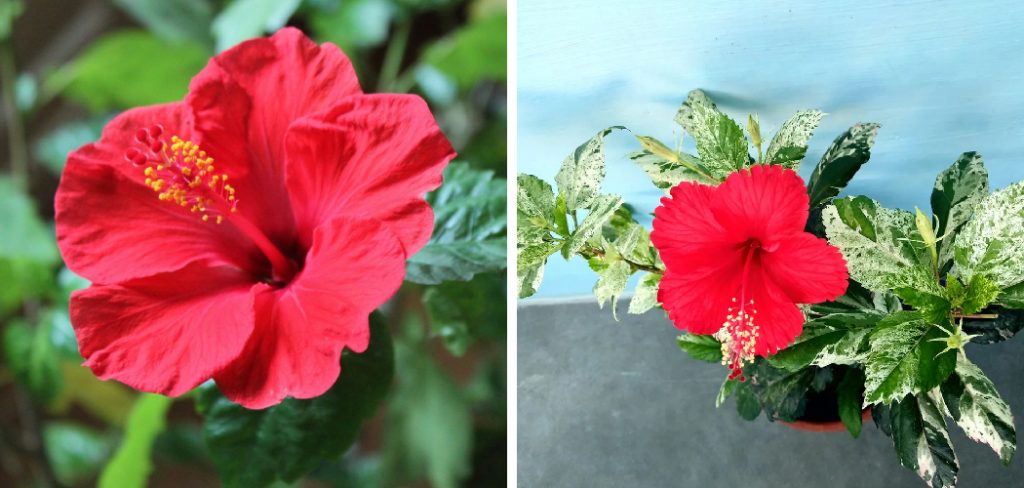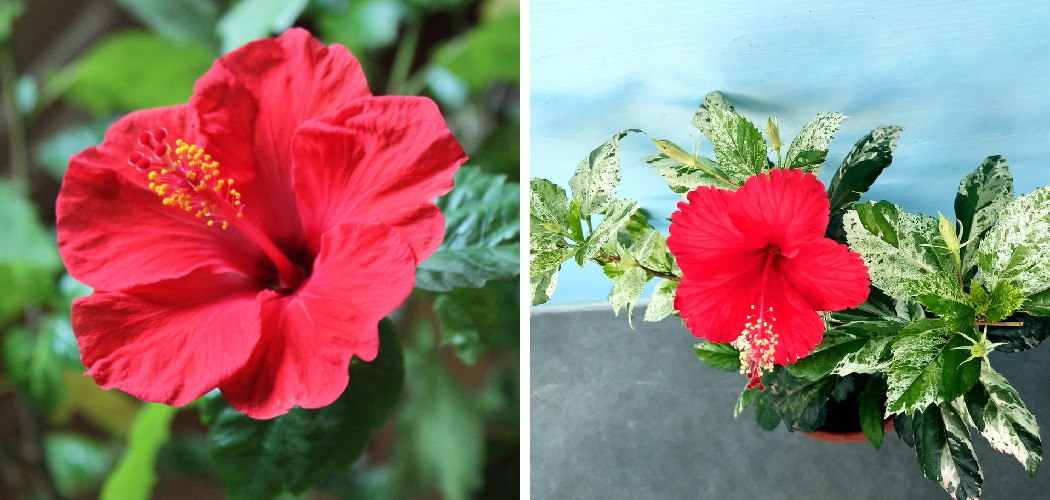To promote flowering in hibiscus, provide ample sunlight and water, maintain proper nutrient levels, and prune regularly. Hibiscus plants thrive with adequate sunlight, water, nutrients, and pruning.
By meeting these needs, you can encourage vibrant blooms in your hibiscus. First, ensure your plant receives at least six hours of direct sunlight each day. Additionally, water your hibiscus regularly, keeping the soil consistently moist but not waterlogged. It’s also crucial to provide the right nutrients by using a well-balanced fertilizer formulated specifically for flowering plants.
Furthermore, proper pruning is essential to remove dead or diseased branches and stimulate new growth. By following these steps, you can promote robust flower production in your hibiscus plants.

How to Promote Flowering in Hibiscus: Step by Step Guide
Understanding The Hibiscus Plant And Its Flowering Process
The hibiscus plant is known for its beautiful flowers, but promoting flowering in hibiscus can sometimes be challenging. Understanding the characteristics of the hibiscus plant is the first step towards encouraging blooming. Hibiscus plants are known for their large, vibrant flowers that come in a variety of colors.
They thrive in well-draining soil and prefer a sunny location. Factors that can affect hibiscus flowering include the amount of sunlight the plant receives, the temperature, and the nutrient levels in the soil. Providing adequate care, such as regular watering and fertilizing, can help promote flowering in hibiscus plants.
Additionally, pruning the plant to remove dead or damaged branches can stimulate new growth and increase the chances of flowering. By understanding the needs of the hibiscus plant and providing the right conditions, you can encourage beautiful blooms to enhance your garden or landscape.
Providing Optimal Growing Conditions For Hibiscus
Providing optimal growing conditions for hibiscus is essential to promote flowering. Choosing the right location for planting is crucial. Select an area with full sun exposure, as hibiscus thrives in bright sunlight. Prepare the soil by adding organic matter to improve drainage.
Avoid waterlogged soil as it can lead to root rot. Watering techniques are also important for healthy flowering. Water hibiscus deeply, allowing the soil to dry slightly before the next watering. Overwatering can cause yellowing leaves and poor flowering. Additionally, mulching around the base of the plant helps retain moisture and suppress weeds.
Regularly fertilize hibiscus with a balanced fertilizer to encourage blooming. Remember to prune the plant regularly to remove dead or damaged branches and shape it. With proper care and attention, your hibiscus will bloom beautifully.
Implementing Proper Pruning Techniques
Pruning plays a vital role in promoting flowering in hibiscus plants. Timing is crucial for pruning, and it should be done during the dormant season to avoid interrupting the blooming cycle. When pruning, remove dead or diseased branches and trim back any crossing or overcrowded stems.
This will stimulate new growth and encourage the plant to produce more flowers. Additionally, pruning helps maintain the overall health and shape of the hibiscus plant. To promote abundant flowering, it’s important to also provide the plant with the right nutrients, sufficient sunlight, and regular watering.
Remember to avoid over-pruning, as this can inhibit blooming. With proper pruning techniques and care, your hibiscus will thrive and showcase a stunning display of vibrant flowers.
Nutritional Requirements For Hibiscus Flowering
Understanding the nutritional needs of hibiscus is crucial for promoting flowering. Choosing the right fertilizer is essential. It is important to fertilize hibiscus regularly and use the correct methods for optimal results. By understanding the nutritional requirements and providing the necessary nutrients, you can encourage the plant to produce vibrant and abundant flowers.
Regular fertilization will ensure that hibiscus receives the necessary nutrients to support healthy growth and promote flowering. Whether you prefer organic or synthetic fertilizers, it is important to choose a product specifically formulated for flowering plants. Applying the fertilizer according to the recommended frequency and using the correct application method will help maximize the flowering potential of your hibiscus plants.
By providing the right nutrients at the right time, you can enjoy the beauty and splendor of blooming hibiscus in your garden.
Managing Pests And Diseases In Hibiscus Plants
Hibiscus plants can be affected by various pests that can hinder their flowering potential. Common pests include aphids, whiteflies, and spider mites, which feed on the plant sap and cause damage. To effectively control these pests, regular inspection is crucial.
Introducing beneficial insects like ladybugs can help control aphids, while sticky traps can capture whiteflies. Additionally, spraying a solution of neem oil mixed with water can deter spider mites. Diseases can also impact hibiscus plants. Recognizing common diseases such as fungal leaf spot and powdery mildew is essential for timely treatment.
Removing infected leaves and employing fungicides can help prevent the spread of these diseases. By managing pests and diseases, hibiscus owners can greatly enhance the flowering potential of their plants.
Propagation Techniques For Increasing Flowering Potential
Propagation is a key factor in promoting flowering in hibiscus plants. There are different methods to propagate these plants, each with its own benefits. Successful propagation requires careful attention to detail and adherence to certain tips. Maximizing the flowering potential of propagated hibiscus plants is essential for beautiful blooms.
With the right techniques, you can ensure that your hibiscus plants thrive and produce an abundance of vibrant flowers. Take the time to learn and implement these propagation methods, and you will enjoy the rewards of a flourishing hibiscus garden.
Additional Tips And Tricks For Promoting Flowering In Hibiscus
To promote flowering in hibiscus, natural remedies and techniques can be used. Proper mulching and weed control practices are essential for maintaining a healthy growth environment. By monitoring and adjusting the environmental conditions, optimal flowering can be achieved. It is important to provide the right amount of light, water, and nutrients to the plants.
Additionally, using organic fertilizers and compost can also aid in enhancing flowering. Pruning the hibiscus regularly helps in stimulating new growth and encourages more flowers to bloom. Moreover, avoiding excessive use of chemical pesticides and opting for natural pest control methods can prevent damage to the flowers.
By following these tips and tricks, hibiscus enthusiasts can ensure a vibrant and flourishing display of flowers in their gardens.
Frequently Asked Questions For How To Promote Flowering In Hibiscus
How Do I Get My Hibiscus To Bloom More?
To get your hibiscus to bloom more, ensure it gets enough sunlight, water it appropriately, apply organic fertilizer, and prune regularly.
What Triggers Hibiscus To Bloom?
Hibiscus blooms when exposed to sunlight for at least six hours a day.
Will Epsom Salt Make Hibiscus Bloom?
Yes, Epsom salt can help hibiscus bloom by providing essential nutrients and promoting healthy growth.
How Do I Keep My Hibiscus Blooming All Summer?
To keep your hibiscus blooming all summer, provide it with proper sunlight, regular watering, balanced fertilizer, and regular pruning.
Conclusion
To ensure the optimal growth and abundant flowering of your hibiscus plants, it is important to follow a few key steps. By providing them with the right amount of sunlight, watering them adequately, implementing proper pruning techniques, and providing sufficient nutrients, you can significantly promote flowering in your hibiscus plants.
First and foremost, hibiscus plants thrive in bright sunlight, so make sure to place them in an area where they can receive at least six hours of direct sunlight per day. Remember to water your plants consistently, keeping the soil moist but not waterlogged.
Pruning your hibiscus regularly is essential to remove dead or weak branches and encourage new growth and blossoms. Furthermore, incorporating organic fertilizers rich in phosphorus and potassium can greatly enhance flower production. When choosing the right fertilizer, opt for slow-release varieties that will provide a steady supply of nutrients over time.
By implementing these guidelines, you can ensure that your hibiscus plants bloom profusely, transforming your garden into a captivating floral oasis. Happy gardening!

